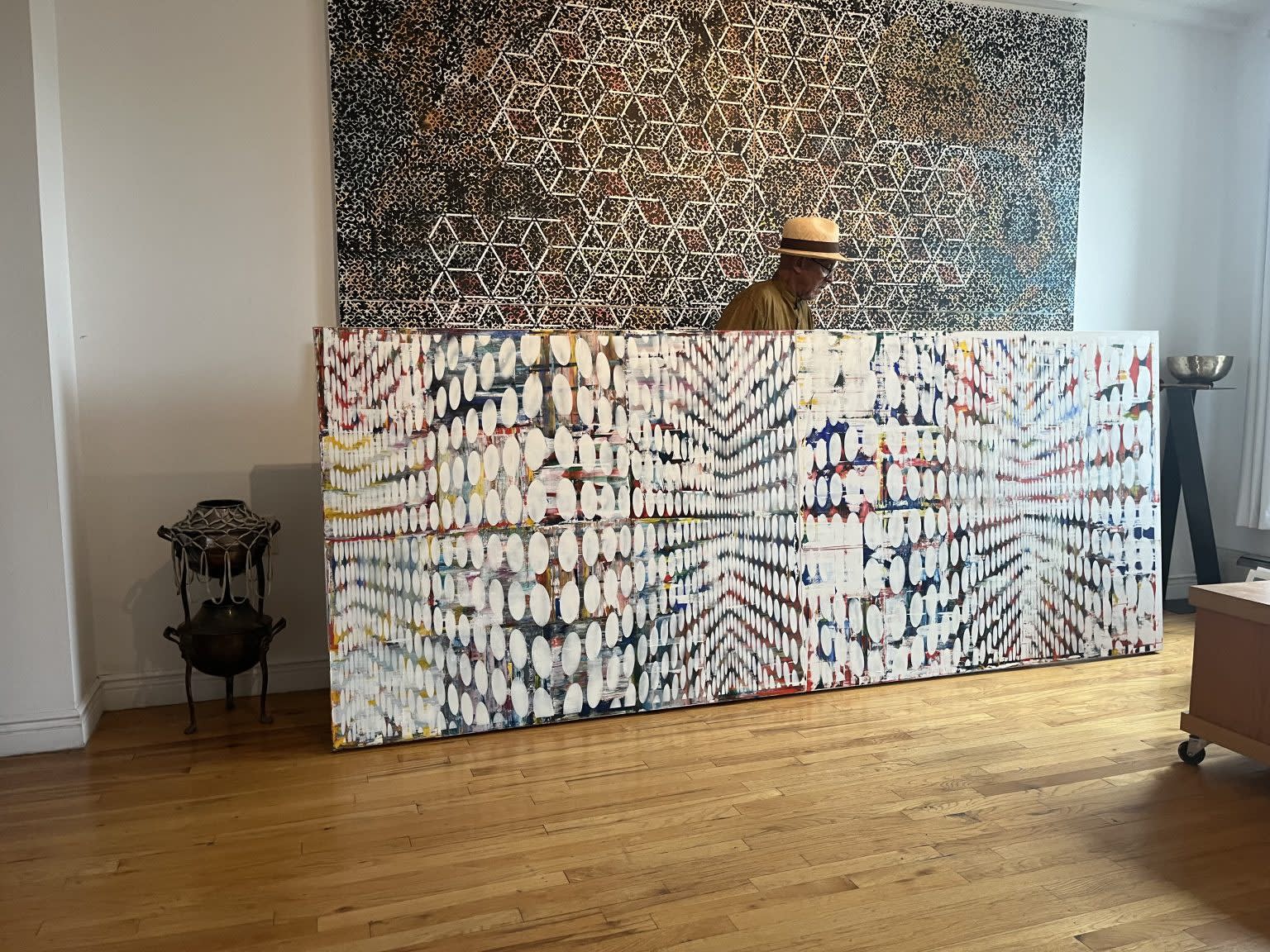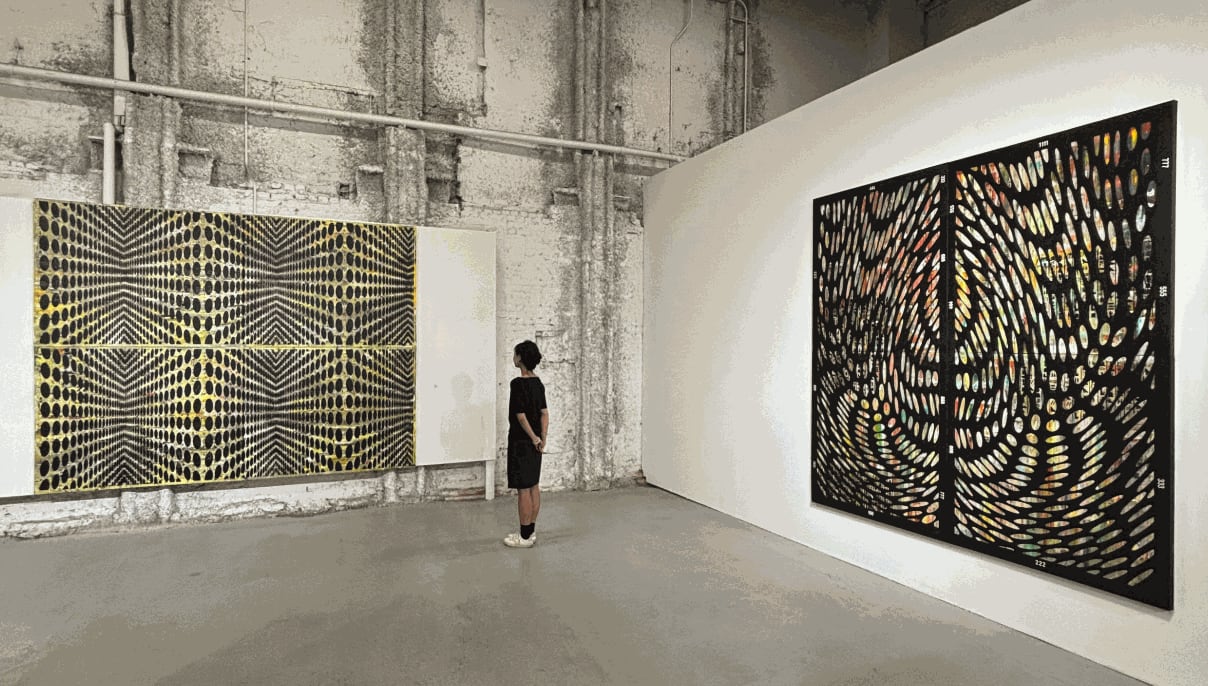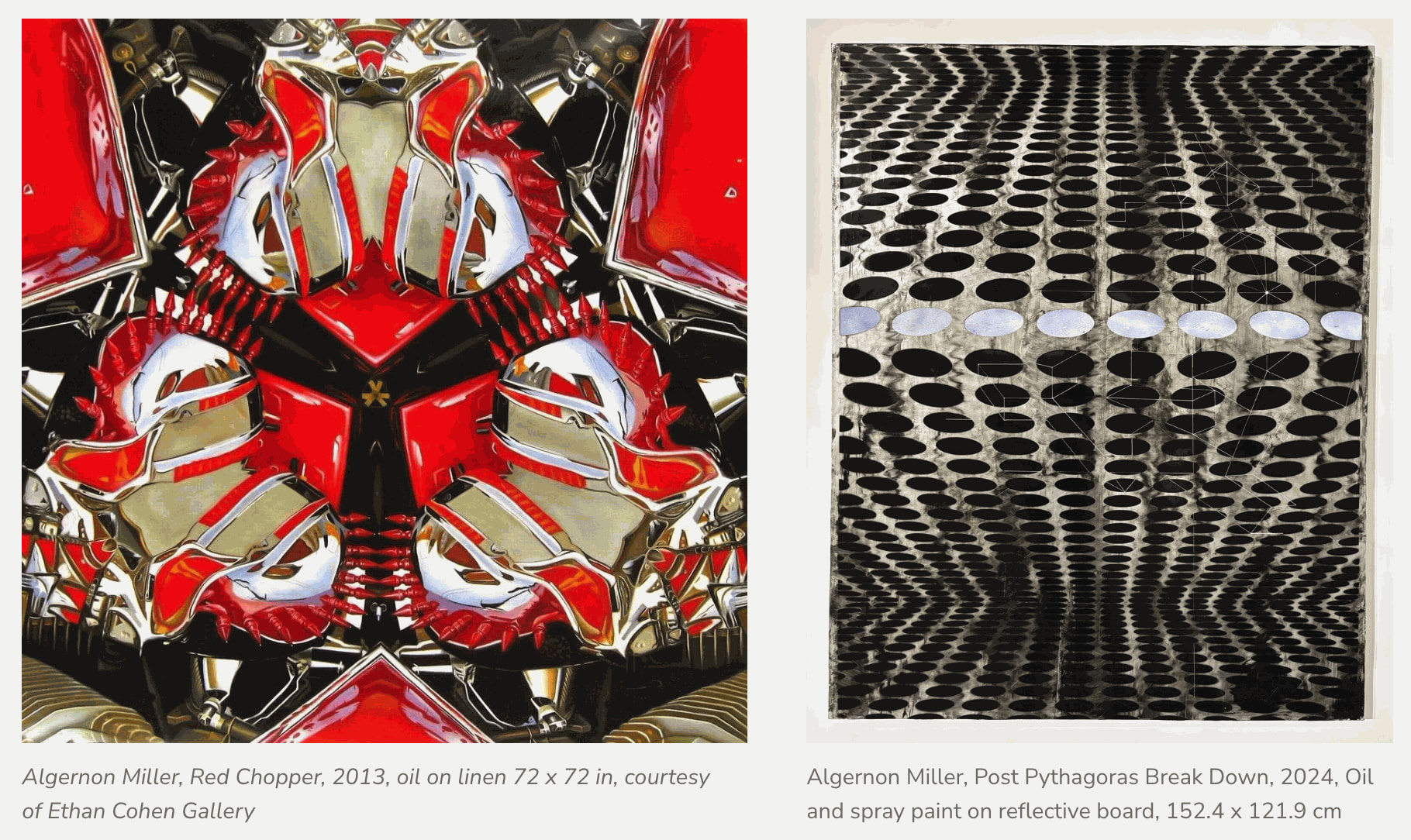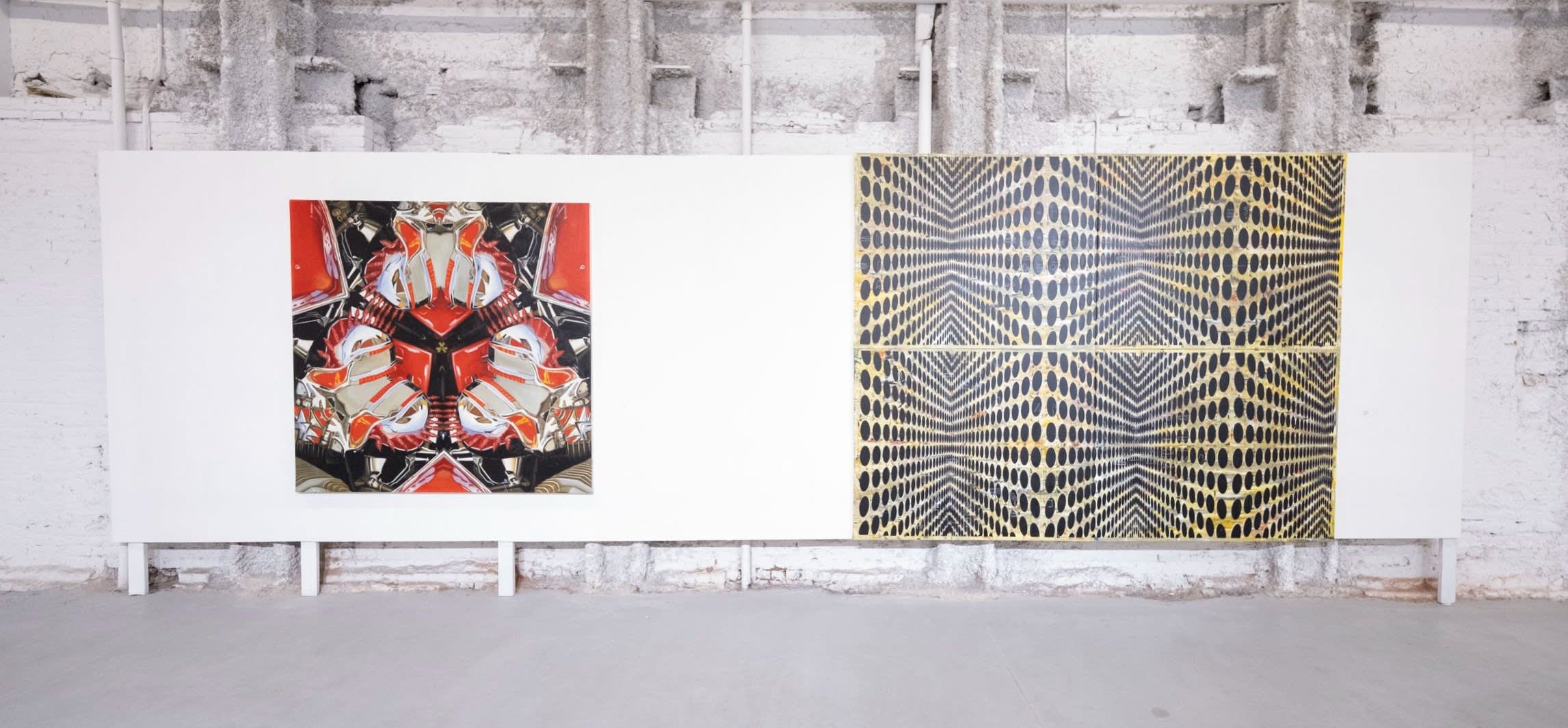Algernon Miller’s work bends space, time, and expectations, redefining what abstraction means when history isn’t optional
I met Algernon Miller the way I tend to meet people in the art world: by asking too many earnest questions at a panel. That day, at a Mel Edwards talk at Hauser & Wirth, I caught a smile from the soft-spoken man next to me. We chatted and clicked. Two native New Yorkers—he from Harlem, I from the Lower East Side—drawn together by chance, we followed each other with no particular reason, and what felt like nothing quietly became something.
Later that evening, I looked him up and learned that his work lives in major museum collections. His legacy was already embedded in the city I’ve written about for decades. I realized I already knew two of his pieces, not from galleries, but from life.
If you’ve walked through Harlem, you’ve likely passed Tree of Hope III, his 1972 abstract sculpture in vivid purple, red, black, green, orange and yellow, standing eight feet tall on 131st Street near what is now Adam Clayton Powell Jr. Boulevard. It’s a rectilinear tribute to a community tradition: the original “tree of hope,” once planted nearby and blessed by Bill “Bojangles” Robinson. Miller was just 27 when his version took root.
But his most recognized contribution may be his architectural design of Frederick Douglass Circle at the northwest corner of Central Park. If you’ve stood on that sundial-shaped platform, its red and yellow granite geometry radiating like a compass rose, you’ve stood inside a Miller. The design isn’t just beautiful; it’s encoded. Inspired by 19th-century African American quilting patterns, some believed to contain directional cues for captive Africans seeking freedom, the work draws from a visual language of resistance, survival, and collective memory. Geometry becomes altar. History becomes infrastructure.
To realize the project, Miller had to prove it wasn’t just aesthetic. He traced the lineage of his forms to histories too often left out of urban planning meetings, presenting research to city officials to ground his design in Black American cultural memory. Geometry, in his hands, isn’t neutral. It’s insurgent. It’s encrypted with resistance. What might look abstract to a passerby is, in fact, a map of liberation layered into stone.
A few months later, I found myself in his Harlem studio for an afternoon visit. It was one of those encounters that rearrange you a little.
Miller cuts a striking figure: dapper, radiant, and unmistakably himself. He favors a palette as intentional as his art. On the day I visited, he wore bright yellow trousers and a mossy green tunic, paired with a crisp Panama hat and round, white-rimmed glasses that gave him the air of a futurist sage. His presence is both relaxed and electric. Even while adjusting a massive canvas or leaning into a story, he radiates precision. He doesn’t dress for flash. He dresses like a man who sees pattern everywhere, including in his own silhouette.

Algernon—Al to friends, and I was now proudly one—shared stories that moved with the rhythm of a lived city: tales of Billie Holiday as a battered neighbor in Queens, of a private art teacher where he learned the rudiments of painting before attending art high school, of Harlem sidewalks once ruled by jump rope games and the bottle-cap strategy sport known as Scully.
Born in 1945, Miller turns 80 this July, though you’d hardly guess it. He carries his years like a man who misplaced the calendar sometime in the 1990s.
He didn’t have much of a relationship with his father, but his mother, Bettijean—like my own mother, Jean—was a neighborhood force. She left Little Rock while pregnant, escaping a difficult relationship, and built a life in New York steeped in books, music, and art. His great-uncle, A.T. Miller, chaired the political caucus that challenged Governor Faubus during the Little Rock crisis. From the beginning, his family braided activism, intellect, and survival into a kind of cultural DNA.
That lineage echoes through his work and is on full display in Afrofuturism and Beyond, now on view at Ethan Cohen Gallery. Downstairs is Miller’s solo show, a sweeping look at his evolution from early experiments with shaped canvases to recent mirror-like pieces that seem to bend space and time. Upstairs, a companion group show titled Afrofuturism, which Miller helped curate, features fellow visionaries Ellsworth Ausby, Nanette Carter, Renee Cox, Ernest Frazier, Tyrone Mitchell, and Joe Overstreet.
On July 10, Miller will join Carter, Cox, and Mitchell in a panel moderated by critic and cultural thinker Seph Rodney, a rare live conversation among artists who helped shape the visual language of Afrofuturism long before the term was coined.

Algernon Miller Afrofuturism and Beyond, Installation view, courtesy of Ethan Cohen Gallery
Miller doesn’t merely create paintings; he constructs portals that feel less like objects on walls and more like thresholds into alternate spatial dimensions, where pigment and geometry conspire to invite reflection, movement, and radical reorientation.
Afrofuturism is a term coined in 1994 by cultural critic Mark Dery in an essay called “Black to the Future.” But the practice long predates the label. It describes the merging of Black history with speculative imagination, where science fiction, African symbolism, music, and political thought come together to envision liberated futures.
It’s not just an aesthetic. It’s a strategy. A way to resist erasure and rewire what’s possible. Think Sun Ra. Think Octavia Butler. Think imagination as armor.
Miller came of age in the 1960s, studying at the School of Visual Arts and The New School while absorbing African studies and Afrocentric thought. He began creating bold geometric works that were unapologetically abstract but deeply tied to diasporic ideas and spiritual design.
At a time when white abstract sculptors often luxuriated in the freedom to be seen as formally neutral and removed from politics, Black artists like Miller worked within and against that same frame, embedding ancestral memory, cosmic logic, and coded resistance into every brushstroke and structure.
As Miller shows, abstraction can be radically political, just in a different key.
In 1979, in a machine shop upstate, Miller stumbled on a material that would change everything: lathe shavings, fine metal coils discarded in piles. Where others saw industrial waste, Miller saw pattern, structure, memory.
He brought them back to his Soho loft and began experimenting. He used the coils as sculptural material, then as stencils, spraying over them to create negative space imagery on canvas. These ghostly forms evolved into a visual language: cosmic, not decorative. Built from logic, not ornament. “I don’t separate the spiritual from the scientific,” he told me. “It’s all code. It’s all light.”
His use of black pigment is particularly revelatory, not because it rejects painterly convention, which often avoids black for fear of flattening, but because it embraces the color as architecture itself, a mass-generating force that organizes and animates the canvas, as seen in Red Chopper (2013) and Post Pythagoras Break Down (2024).

In his newer pieces on reflective board, the surface itself becomes an event. Stand in front of one and you shimmer back, fragmented, multiplied. You’re not just looking at the work. You’re stepping into a portal.
That sense of being folded into the composition extends beyond the gallery. It’s there in the Frederick Douglass Circle. It’s there in his Tree of Hope sculpture. It’s there in his civic projects, in his decades of community programming, in the neighborhoods shaped by his vision. And it thrums through the lower level of Ethan Cohen.
His toolkit is as wide-ranging as his imagination: pigment, sacred geometry, pattern-generating software, solar-powered light, even holography. He doesn’t sand down his ideas to fit trends. He’s not trying to dazzle. He’s trying to transmit.

Algernon Miller Afrofuturism and Beyond, Installation view, courtesy of Ethan Cohen Gallery
As Miller and his peers knew, the speculative wasn’t an escape. It was a blueprint for survival. Sun Ra may have said he was from Saturn, but he also built a terrestrial sonic resistance to erasure. Miller, too, builds portals not to flee this world, but to reimagine it.
When Miller talks about “transformationist consciousness,” he is not indulging in art-speak or branding jargon, but offering a deeply considered worldview that fuses ancestral knowledge, lived experience, and future possibility into a single charged surface.
In a moment flooded with noise and surface gloss, Afrofuturism and Beyond offers something different: depth, rigor, resonance. These works don’t ask to be glanced at. They ask to be inhabited. They reward patience. They make the viewer active.
At the upcoming panel, Miller won’t be the loudest voice, but he may be the most essential. He’s not speaking in slogans. He’s offering a language. He’s describing a way of seeing, a way of making, and a way forward.
Sometimes you meet someone by accident at a lecture, and that accidental meeting becomes a key, not to mention a portal and an invitation.
I’m glad I asked too many questions that afternoon. I made a new friend and saw the future rendered in brushstrokes.
Afrofuturism and Beyond is on view through July 12, 2025 at Ethan Cohen Gallery, 225 West 17th Street, New York City.
Panel Discussion: Afrofuturism
Moderated by Seph Rodney
Panelists: Algernon Miller, Nanette Carter, Renee Cox, and Tyrone Mitchell
Thursday, July 10, 2025 | 6–8 PM
Ethan Cohen Gallery, 225 W 17th Street, NYC
About the writer: Laurie Gwen Shapiro’s new narrative nonfiction book, The Aviator and the Showman, about Amelia Earhart and her husband, George Putnam, published by Viking on July 15. An excerpt appeared in The New Yorker in early June. @lauriestories
Related articles:
https://artspiel.org/judy-pfaff-taught-them-to-break-the-rules-now-theyre-sharing-the-stage
https://artspiel.org/sensuously-severe-why-artists-call-don-voisine-the-real-deal/

